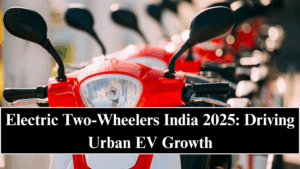India’s electric mobility revolution is now being led by electric two-wheelers—affordable, efficient, and perfectly suited to the country’s growing urban population. In 2025, these vehicles have become the backbone of India’s clean mobility push, reshaping how millions commute every day. With rising fuel prices, government subsidies, and advancements in battery technology, electric scooters and bikes are now more practical and accessible than ever.

The Shift Toward Electric Mobility
The Indian two-wheeler market is one of the largest in the world, with over 200 million riders. However, growing environmental concerns and volatile fuel prices have driven a rapid shift toward electrification. In 2025, EV adoption in the two-wheeler segment accounts for nearly 30% of total new sales—a dramatic leap from under 5% just a few years ago.
This shift is powered by three main drivers:
-
Lower running costs: Electric bikes cost one-tenth per kilometer compared to petrol vehicles.
-
Government incentives: Schemes like FAME-II and state-level EV policies offer up to ₹40,000 subsidies per vehicle.
-
Improved technology: Next-gen lithium-ion and LFP batteries now offer higher range and faster charging.
Together, these factors are transforming Indian streets into cleaner, quieter, and smarter mobility networks.
Leading Electric Two-Wheeler Brands in India
India’s EV landscape in 2025 is dominated by a mix of homegrown innovators and established automakers. Some of the key players include:
-
Ola Electric: Leading the market with performance-oriented e-scooters and fast-charging infrastructure.
-
Ather Energy: Known for its smart, connected scooters offering AI-assisted ride modes.
-
TVS and Hero MotoCorp: Scaling up mass-market EVs for budget-conscious commuters.
-
Bajaj Chetak: Reviving its iconic brand with sleek, urban-friendly electric variants.
-
Ampere and Okinawa: Offering affordable models targeting tier-2 and tier-3 cities.
The competition is fierce, but the result benefits consumers—more choices, better technology, and affordable pricing.
Urban Mobility Transformation
Electric two-wheelers have become central to India’s urban mobility ecosystem, especially in metro cities like Bengaluru, Delhi, and Pune. Shared mobility services are adopting e-scooters for last-mile connectivity, while logistics and delivery giants such as Zomato, Swiggy, and Amazon have transitioned large portions of their fleets to electric models.
Cities are adapting too, with:
-
Dedicated EV lanes and parking zones.
-
Widespread charging points at metro stations, malls, and residential areas.
-
Smart app integration, allowing riders to locate and reserve chargers easily.
This ecosystem ensures that India’s urban transport remains both sustainable and scalable.
The Role of Battery Swapping and Charging Networks
Battery swapping is a game-changer for India’s EV revolution. In 2025, battery swap stations have expanded across major cities, allowing riders to replace batteries within minutes instead of waiting hours to charge.
Key developments include:
-
Government-backed policies promoting standardized battery formats.
-
Private players like Sun Mobility and Bounce Infinity scaling swap networks nationwide.
-
AI-managed energy stations optimizing grid load and reducing downtime.
Meanwhile, fast-charging hubs have become more accessible, offering 80% charge in less than 30 minutes. Together, these innovations are removing “range anxiety,” one of the last barriers to full EV adoption.
Environmental and Economic Benefits
Switching to electric two-wheelers offers a massive environmental payoff. In 2025, the sector helps India reduce over 12 million tons of CO₂ emissions annually. Moreover, locally manufactured batteries and vehicles reduce import costs, keeping the EV economy self-sustained.
Economic advantages include:
-
Lower total cost of ownership (TCO): EVs are 40–50% cheaper to maintain over their lifespan.
-
Job creation: Thousands of new roles in manufacturing, charging infrastructure, and EV maintenance.
-
Reduced oil imports: Supporting India’s energy independence goals.
By combining economic opportunity with sustainability, electric two-wheelers are proving to be both a financial and environmental win.
The Road Ahead for India’s Two-Wheeler EV Market
The future of electric mobility in India looks promising. Industry experts predict that by 2030, one in every two two-wheelers sold will be electric, driven by improvements in affordability and infrastructure.
Emerging trends include:
-
Swappable solid-state batteries for higher energy density.
-
Smart insurance plans integrated with ride data.
-
AI-powered ride optimization for fleet efficiency.
-
Expansion of EV exports from India to Southeast Asia and Africa.
With strong policy backing and continuous innovation, India is positioning itself as a global hub for electric two-wheelers in the coming decade.
FAQs
Why are electric two-wheelers growing so fast in India?
Because they’re affordable, efficient, and supported by strong government incentives and local innovation.
How much can riders save with an electric scooter?
EV riders save up to ₹15,000–₹20,000 annually on fuel and maintenance costs compared to petrol scooters.
Which brands are leading the electric two-wheeler market?
Top players include Ola Electric, Ather Energy, Hero MotoCorp, TVS, and Bajaj.
Is battery swapping available across India?
Yes, major cities now have hundreds of swap stations supported by both public and private initiatives.
What is the future of India’s EV two-wheeler sector?
The sector is moving toward mass electrification, smart connectivity, and export-oriented manufacturing by 2030.
Click here to know more.
